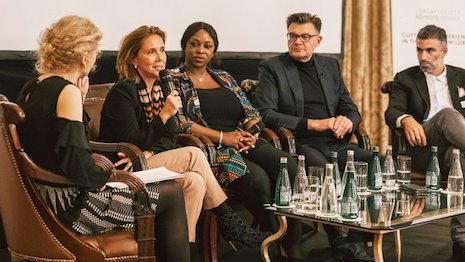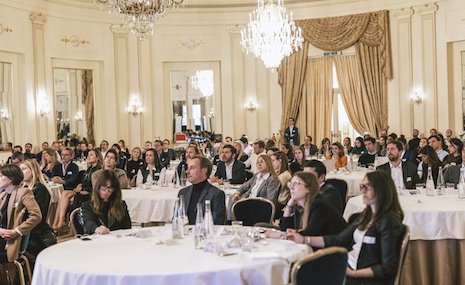 Luxury Society Keynote Geneva panel. Image credit: Luxury Society
Luxury Society Keynote Geneva panel. Image credit: Luxury Society
GENEVA, Switzerland – The halls of The Four Seasons Geneva were bustling Feb. 26 with professionals from all spheres of the luxury industry.
This year’s Luxury Society Keynote gathered more than 100 attendees representing 60 luxury and premium brands including luxury watch and jewelry houses Cartier, Chopard, Patek Philippe, Breitling, Audemars Piguet, Jaeger-LeCoultre and Piaget, but also well-established beauty, finance and fashion brands L'Occitane, Clarins, Union Bancaire Privée (UBP) and Ralph Lauren.
These diverse minds all came together to address a compelling challenge for today’s age: how can brands effectively enhance the customer journey to reach an increasingly dynamic consumer-base?
Luxury Society’s parent company, international-based digital marketing agency DLG (Digital Luxury Group), has held conferences across the world in Shanghai, Paris, New York, and London in past years.
The objective of this year’s conference, in collaboration with CNNMoney Switzerland and Facebook, was to give luxury brands a cross-industry perspective on the customer experience by bringing together speakers and guests who might not otherwise cross paths.
First-time Switzerland panel speakers from Facebook, Moncler, BMW and Piaget, in addition to DLG, offered in-depth discussions on how luxury brands can streamline their efforts to develop help seamless omnichannel journeys.
 Luxury Society Keynote Geneva 2020 audience. Image credit: Luxury Society
Luxury Society Keynote Geneva 2020 audience. Image credit: Luxury Society
Below you will find key analyses and solutions to help address the core challenges faced by the luxury industry today, provided by some of the most innovative and successful strategists in the business.
Facebook: From storytelling to story-selling
Morin Oluwole, global head of luxury at Facebook and Instagram, discussed how technology now enables all brands and marketers to strengthen many aspects of the consumer relationship and potential clients, including their purchase journey.
“At Facebook, we have 2.3 billion people that use the platform every single day,” Ms. Oluwole said. “Of course, the consumers that are most important for you are luxury consumers, those people who are passionate about your brands.
“The way we think about this perception is the four Cs: curation, community, conversation and commerce,” she said.
By using these four elements, luxury brands can implement communication strategies that engage customers in innovative and interactive ways, ultimately driving more conversion.
“We live in a world where we are all constantly on our phones,” Ms Oluwole said. “Fashion and luxury are very strong passion points and we estimate that this engaged community connects on Instagram more than 30 times a day.
“It’s important in this world of almost heavy data-overload to really think about the point of view that you express and make sure that curation helps the consumer understand what is the objective of your brand,” she said. “People want more curated and tailored experiences.”
Ms. Oluwole emphasized the importance of developing meaningful relationships with different consumers, citing that 70 percent of luxury clients each year are new clients.
“There is continuous work that needs to be done to make sure people know about your brand, and also to create brand awareness over time,” she said.
As one of the first members of the Facebook team, Ms. Oluwole also shared insights on the huge influence which digital has on luxury consumers.
For more than 50 percent of new clients, the very first touch point, or first communication with the brand, starts with digital.
“I think the most important fact is, when we look at online and physical purchases, online is growing and it’s growing at a pace that is not compromising the purchases that consumers are making in store, it’s actually adding to your overall business objectives,” Ms. Oluwole said.
In addition to luxury consumers shopping online, luxury brands also look at just how consumers navigate.
In 2018, 61 percent of online purchases were made through mobile, versus desktop.
“Globally, especially thanks to platforms like Facebook and Instagram, it has really evolved and there is a need to build these relationships,” Ms. Oluwole said.
As for what Facebook and Instagram are cooking up for the future?
Ms. Oluwole says the platforms are continuing to work on more seamless experiences for the luxury customer, including search content, artificial intelligence, augmented reality and integrating secure and direct check-out.
The Moncler way
Roberto Eggs, Moncler’s chief marketing and operating officer, discussed the latest developments for Moncler’s "Genius" strategy, a shift toward digital advertising, and coordination as a key ingredient for success.
Mr. Eggs helped Moncler establish itself as a much-desired brand via internal digital transformation at all levels of the company and a shift from regular fashion to always-on fashion.
With Moncler’s “Genius” strategy, launched in 2018, consumers saw the overhaul of slow fashion jolted into monthly collaborations to feed the growing obsession with all things “new.”
Mr. Eggs dove into the brand history, explaining how the French-founded ski-wear company was able to impressively jump to one of the most successful names in luxury.
“For 10 years, we were happy with the results of the company, but we really started sensing that the consumer was changing, especially linked to the emergence of digital and social media,” Mr. Eggs said. “What was the best way to make this evolution?”
Key strategies in the Moncler transformation
- Optimizing the retail space
- Building communities, consumer behavior
- Digitalization of the company
- “Genius” concept
“The first big move that we did was really to work on the retail base,” Mr. Eggs said.
“We started working with all the store managers and key leaders to redesign the consumer experience based on client priorities,” he said.
After starting with the physical spaces and building brand values and growth within the corporate ladder, Moncler began to look at the overall omnichannel strategy for the brand.
“We try to look at all the touch points that the client has, linking it to sales and forming one comprehensive view of the consumer,” Mr. Eggs said.
To do this, Moncler implemented strategies that create a network to connect all touch points.
If a client looks at a new collection or specific pieces online, they can then go to a physical store with a sales associate already having an idea for what they are looking.
Allowing customers to order from anywhere, and having a consistent retail experience, regardless of where, has been key to winning over Moncler customers.
After strengthening the brand core values throughout the years, Moncler eventually moved to perhaps its most innovative project yet: Genius.
“We thought about a different approach,” Mr. Eggs said.
“Moncler has been doing collaborations since 2003, but most people had never heard of it,” he said. “I thought we could use this concept of collaboration to create more content and to be able to say something different to the consumer.
“The concept is based on digitalization, it’s now 12 collections, one per month. It’s not fast-fashion, each capsule is a real capsule.”
Working with a curated, diverse selection of artists and designers has enabled Moncler to reach different segments of consumers, all while maintaining its brand integrity.
Panel: The key to winning
After a quick espresso break and some mingling, CNNMoney Switzerland anchor Ana Maria Montero monitored an all-star panel of our guest speakers, with the warm welcomed additions of Piaget chief digital officer Julie Thompson and DLG founder/CEO David Sadigh.
Together, the five industry leaders discussed the most important channels to touch consumers, the consumer journey, and the current climate of luxury culture.
Ms. Thompson opened up the panel discussion by discussing the challenges brands face today to cater to different clients, and the fact that there is no one “luxury consumer.”
“Our clients are spread across many geographies, many in China, but also in the Middle East, Europe, Korea and Japan,” Ms. Thompson said.
“We are talking about a huge scope of different clients,” she said. “Meaning that to cater to different clients, you need different variants in the consumer journey. There is not one consumer journey, but many variants.”
Whether it be Facebook, Moncler, Piaget or DLG, all of the panel agreed that a huge part of raising awareness and reaching clients, particularly new clients, includes optimizing social media channels and incorporating technology in a way that enhances the customer relationship.
“Social is where our audience is, and this is where we need to be in terms of the conversation,” Ms. Thompson said.
“We’ve seen a huge increase in our online business in the last few years, but it’s still not the majority of where we have our sales,” she said. “Conversion is more about generating leads to our brick-and-mortars.”
Another highlight of the panel was the importance of taking risks, but also knowing where not to go and what not to do.
As important as innovation and creation are in the customer experience, focusing on the right priorities carries equal weight.
“Things are changing extremely fast everywhere,” LSK host Mr. Sadigh said.
“Luxury brands really need to find the line between strategy and culture and how to find the essence so that these two are aligned,” he said.
Digital Luxury Group: Optimizing search performance
Benjamin Dubuc, head of search and performance media at DLG, shared insights on how beauty industry customers search online and what they expect from their digital experience.
“Do you remember what your last search was?” Mr. Dubuc said.
Keynote attendees scrunched their foreheads as most looked unsure of the answer.
In today’s digital age, we have an overload of information. Most of us use search on a daily basis, multiple times a day.
While this may seem insignificant for users, the wealth of behavioral information available can be extremely useful for luxury brands and marketers.
“By tapping into these search insights, we can learn a lot about our consumers,” Mr. Dubuc said.
DLG’s latest research looked at 28 beauty brands with skincare as their main product by analyzing Google searches in English globally, finding the leading channel in which those searches were performed was mobile, accounting for 77 percent of total skincare searches in 2019, up 26 percent three years ago.
“We also used specific keyword searches to see what we can learn from users, and we can also do that across all industries, from watches to jewelry to the automotive industry,” Mr. Dubuc said.
Top steps to lead with empathy
- Listen to your consumers
- Adapt to their new behavior
- Create frictionless experiences
“Consumers today are more curious, demanding, and impatient than ever before,” Mr. Dubuc said.
With 77 percent of skincare searches performed on mobile in 2019, brands need to be more attentive to what customers want, including brands fulfilling their intent and allowing customers to find the right product.
Search has transformed the way customers buy and the way they consumer information, Mr. Dubuc said. As marketers, this should change the way we talk to consumers.
Overall, search interest for skincare brands is growing.
Over the past three years, skincare search volumes that demonstrate customer intent – from awareness and research, to ecommerce or physical purchase – have grown by 51 percent.
Established brands such as Neutrogena, SkinCeuticals, La Roche-Posay and La Mer are keeping pace with the younger upstarts in the market.
Neutrogena and SkinCeuticals search volumes grew by 117 percent and 116 percent, respectively, La Roche-Posay climbed by 106 percent and La Mer rose by 89 percent, demonstrating the opportunity for more traditional skincare brands to keep building momentum within the fast-changing beauty market.
“It has never been easier as a brand to reach clients, but it also has never been harder to please them,” Mr. Dubuc said.
The brands that are winning today are not those who are focusing on competition, but rather those that encompass a customer-centric, community-based, digital-first strategy.
BMW: Building brand identity to talk to your audience
Tobias Weber, BMW head of brand and entertainment cooperations and KOL relations, gave attendees a comprehensive look on just how BMW has managed to speak to its diverse audience over the years.
"The one question that you might have is ‘how do we make sure that this is all connected? What is our secret ingredient to make this all happen?” Mr. Weber said.
"Everything is based on ‘sheer driving pleasure,’’ he said. “This is not only what differentiates us from the competition, but is also what every single one of our products is about.
“So if it’s about driving and enjoying yourself, I would say BMW is the ultimate and I think this claim pulls it all together and is the basis of all that you see.”
Finding the right partnerships has been a key component in speaking to BMW’s diverse array of customers.
“It’s not only about coming up with products that are joyful, but also about communication and about being spontaneous and not too staged,” Mr. Weber said.
“One thing that’s really important for us right now is reaching out to younger target groups as well,” he said. “We have to make sure that we still stay in touch with the customers of the future.”
Throughout recent years, BMW’s campaign strategy has placed a heavy emphasis on partnerships, some more unlikely than others. These include:
- Eyes on Gigi, 2016: BMW released its “digital-first” campaign for the new BMW M2 Coupé. Stars of the campaign “Eyes on Gigi” were the then-new BMW M2 Coupé and U.S. supermodel Gigi Hadid, who appeared in front of the camera for an automobile brand for the first time.
- Brooklyn Beckham, 2019: Brooklyn Beckham loves to photograph the moment. The nascent photographer joined BMW for a first photoshoot with the BMW Z4 in Palm Springs – and an interview to talk about his love story with the camera. Since then he is a passionate brand ambassador.
- Road to Coachella: BMW has been an official partner of the Coachella Valley Music & Arts Festival for three years, already having a legacy with the social campaign #RoadToCoachella and in working with relevant talent that is performing (e.g. Khalid in 2018).
- Need For Speed: “Need For Speed: Payback” puts the player behind the wheel of a virtual dreamcar fleet, and behind the wheel of the deceptively realistic new BMW M5.
- The Iconic “Mission: Impossible” Franchise
“I think taking risks is an essential part of the company, and I think we’ve proven that it’s worth it,” Mr. Weber said.
 Meaghan Corzine is a writer at Luxury Society
Meaghan Corzine is a writer at Luxury Society
Published with permission from Luxury Society, a division of DLG (Digital Luxury Group). Edited for clarity and style.
